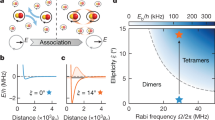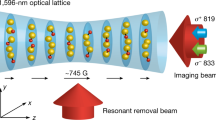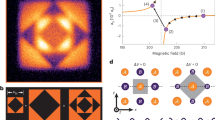Abstract
Ultracold assembly of diatomic molecules has enabled great advances in controlled chemistry, ultracold chemical physics and quantum simulation with molecules1,2,3. Extending the ultracold association to triatomic molecules will offer many new research opportunities and challenges in these fields. A possible approach is to form triatomic molecules in a mixture of ultracold atoms and diatomic molecules by using a Feshbach resonance between them4,5. Although ultracold atom–diatomic-molecule Feshbach resonances have been observed recently6,7, using these resonances to form triatomic molecules remains challenging. Here we report on evidence of the association of triatomic molecules near the Feshbach resonance between 23Na40K molecules in the rovibrational ground state and 40K atoms. We apply a radio-frequency pulse to drive the free-bound transition in ultracold mixtures of 23Na40K and 40K and monitor the loss of 23Na40K molecules. The association of triatomic molecules manifests itself as an additional loss feature in the radio-frequency spectra, which can be distinguished from the atomic loss feature. The observation that the distance between the association feature and the atomic transition changes with the magnetic field provides strong evidence for the formation of triatomic molecules. The binding energy of the triatomic molecules is estimated from the measurements. Our work contributes to the understanding of the complex ultracold atom–molecule Feshbach resonances and may open up an avenue towards the preparation and control of ultracold triatomic molecules.
This is a preview of subscription content, access via your institution
Access options
Access Nature and 54 other Nature Portfolio journals
Get Nature+, our best-value online-access subscription
$29.99 / 30 days
cancel any time
Subscribe to this journal
Receive 51 print issues and online access
$199.00 per year
only $3.90 per issue
Buy this article
- Purchase on Springer Link
- Instant access to full article PDF
Prices may be subject to local taxes which are calculated during checkout



Similar content being viewed by others
Data availability
All data generated or analysed during this study are included in this published article (and its supplementary information files). Source data are provided with this paper.
References
Krems, R. V. Cold controlled chemistry. Phys. Chem. Chem. Phys. 10, 4079–4092 (2008).
Carr, L. D., DeMille, D., Krems, R. V. & Ye, J. Cold and ultracold molecules: science, technology and applications. New J. Phys. 11, 055049 (2009).
Quéméner, G. & Julienne, P. S. Ultracold molecules under control. Chem. Rev. 112, 4949–5011 (2012).
Chin, C., Grimm, R., Julienne, P. & Tiesinga, E. Feshbach resonances in ultracold gases. Rev. Mod. Phys. 82, 1225–1286 (2010).
Köhler, T., Góral, K. & Julienne, P. S. Production of cold molecules via magnetically tunable Feshbach resonances. Rev. Mod. Phys. 78, 1311–1361 (2006).
Yang, H. et al. Observation of magnetically tunable Feshbach resonances in ultracold 23Na40K + 40K collisions. Science 363, 261–264 (2019).
Wang, X.-Y. et al. Magnetic Feshbach resonances in collisions of 23Na40K with 40K. New J. Phys. 23, 115010 (2021).
Shuman, E. S., Barry, J. F. & DeMille, D. Laser cooling of a diatomic molecule. Nature 467, 820–823 (2010).
Barry, J. F. et al. Magneto-optical trapping of a diatomic molecule. Nature 512, 286–289 (2014).
Cheuk, L. W. et al. Λ-enhanced imaging of molecules in an optical trap. Phys. Rev. Lett. 121, 083201 (2018).
Caldwell, L. et al. Deep laser cooling and efficient magnetic compression of molecules. Phys. Rev. Lett. 123, 033202 (2019).
Ding, S., Wu, Y., Finneran, I. A., Burau, J. J. & Ye, J. Sub-Doppler cooling and compressed trapping of YO molecules at μK temperatures. Phys. Rev. X 10, 021049 (2020).
Ni, K.-K. et al. A high phase-space-density gas of polar molecules. Science 322, 231–235 (2008).
Molony, P. K. et al. Creation of ultracold 87Rb133Cs molecules in the rovibrational ground state. Phys. Rev. Lett. 113, 255301 (2014).
Takekoshi, T. et al. Ultracold dense samples of dipolar RbCs molecules in the rovibrational and hyperfine ground state. Phys. Rev. Lett. 113, 205301 (2014).
Park, J. W., Will, S. A. & Zwierlein, M. W. Ultracold dipolar gas of fermionic 23Na40K molecules in their absolute ground state. Phys. Rev. Lett. 114, 205302 (2015).
Guo, M. et al. Creation of an ultracold gas of ground-state dipolar 23Na87Rb molecules. Phys. Rev. Lett. 116, 205303 (2016).
Rvachov, T. M. et al. Long-lived ultracold molecules with electric and magnetic dipole moments. Phys. Rev. Lett. 119, 143001 (2017).
Seeßelberg, F. et al. Modeling the adiabatic creation of ultracold polar 23Na40K molecules. Phys. Rev. A 97, 013405 (2018).
Voges, K. K. et al. Ultracold gas of bosonic 23Na39K ground-state molecules. Phys. Rev. Lett. 125, 083401 (2020).
Liu, L. R. et al. Building one molecule from a reservoir of two atoms. Science 360, 900–903 (2018).
He, X. et al. Coherently forming a single molecule in an optical trap. Science 370, 331–335 (2020).
Ospelkaus, S. et al. Quantum-state controlled chemical reactions of ultracold potassium-rubidium molecules. Science 327, 853–857 (2010).
Hu, M.-G. et al. Direct observation of bimolecular reactions of ultracold KRb molecules. Science 366, 1111–1115 (2019).
Son, H., Park, J. J., Ketterle, W. & Jamison, A. O. Collisional cooling of ultracold molecules. Nature 580, 197–200 (2020).
DeMarco, L. et al. A degenerate Fermi gas of polar molecules. Science 363, 853–856 (2019).
Valtolina, G. et al. Dipolar evaporation of reactive molecules to below the Fermi temperature. Nature 588, 239–243 (2020).
Kozyryev, I. et al. Sisyphus laser cooling of a polyatomic molecule. Phys. Rev. Lett. 118, 173201 (2017).
Zeppenfeld, M. et al. Sisyphus cooling of electrically trapped polyatomic molecules. Nature 491, 570–573 (2012).
Mitra, D. et al. Direct laser cooling of a symmetric top molecule. Science 369, 1366–1369 (2020).
Qiu, M. et al. Observation of Feshbach resonances in the F + H2 → HF + H reaction. Science 311, 1440–1443 (2006).
Vogels, S. N. et al. Imaging resonances in low-energy NO-He inelastic collisions. Science 350, 787–790 (2015).
Chefdeville, S. et al. Observation of partial wave resonances in low-energy O2–H2 inelastic collisions. Science 341, 1094–1096 (2013).
Klein, A. et al. Directly probing anisotropy in atom–molecule collisions through quantum scattering resonances. Nat. Phys. 13, 35–38 (2017).
Regal, C. A., Ticknor, C., Bohn, J. L. & Jin, D. S. Creation of ultracold molecules from a Fermi gas of atoms. Nature 424, 47–50 (2003).
Herbig, J. et al. Preparation of a pure molecular quantum gas. Science 301, 1510–1513 (2003).
Thompson, S. T., Hodby, E. & Wieman, C. E. Ultracold molecule production via a resonant oscillating magnetic field. Phys. Rev. Lett. 95, 190404 (2005).
Ospelkaus, C. et al. Ultracold heteronuclear molecules in a 3D optical lattice. Phys. Rev. Lett. 97, 120402 (2006).
Lompe, T. et al. Radio-frequency association of Efimov trimers. Science 330, 940–944 (2010).
Nakajima, S., Horikoshi, M., Mukaiyama, T., Naidon, P. & Ueda, M. Measurement of an Efimov trimer binding energy in a three-component mixture of 6Li. Phys. Rev. Lett. 106, 143201 (2011).
Machtey, O., Shotan, Z., Gross, N. & Khaykovich, L. Association of Efimov trimers from a three-atom continuum. Phys. Rev. Lett. 108, 210406 (2012).
Christianen, A., Zwierlein, M. W., Groenenboom, G. C. & Karman, T. Photoinduced two-body loss of ultracold molecules. Phys. Rev. Lett. 123, 123402 (2019).
Gregory, P. D., Blackmore, J. A., Bromley, S. L. & Cornish, S. L. Loss of ultracold 87Rb133Cs molecules via optical excitation of long-lived two-body collision complexes. Phys. Rev. Lett. 124, 163402 (2020).
Liu, Y. et al. Photo-excitation of long-lived transient intermediates in ultracold reactions. Nat. Phys. 16, 1132–1136 (2020).
Nichols, M. A. et al. Detection of long-lived complexes in ultracold atom-molecule collisions. Preprint at https://arxiv.org/abs/2105.14960 (2021).
Balakrishnan, N. On the role of van der Waals interaction in chemical reactions at low temperatures. J. Chem. Phys. 121, 5563–5566 (2004).
Krems, R. & Dalgarno, A. Quantum-mechanical theory of atom-molecule and molecular collisions in a magnetic field: spin depolarization. J. Chem. Phys. 120, 2296–2307 (2004).
Lepers, M. & Dulieu, O. Long-range interactions between ultracold atoms and molecules including atomic spin–orbit. Phys. Chem. Chem. Phys. 13, 19106–19113 (2011).
Żuchowski, P. S., Kosicki, M., Kodrycka, M. & Soldán, P. van der Waals coefficients for systems with ultracold polar alkali-metal molecules. Phys. Rev. A 87, 022706 (2013).
Gao, B. Angular-momentum-insensitive quantum-defect theory for diatomic systems. Phys. Rev. A 64, 010701 (2001).
Gao, B., Tiesinga, E., Williams, C. J. & Julienne, P. S. Multichannel quantum-defect theory for slow atomic collisions. Phys. Rev. A 72, 042719 (2005).
Crubellier, A. & Luc-Koenig, E. Threshold effects in the photoassociation of cold atoms: R−6 model in the Milne formalism. J. Phys. B At. Mol. Opt. Phys. 39, 1417 (2006).
Crubellier, A., González-Férez, R., Koch, C. P. & Luc-Koenig, E. Asymptotic model for shape resonance control of diatomics by intense non-resonant light. New J. Phys. 17, 045020 (2015).
Gao, B. Multichannel quantum-defect theory for anisotropic interactions. Preprint at https://arxiv.org/abs/2008.08018 (2020).
Son, H. et al. Control of reactive collisions by quantum interference. Preprint at https://arxiv.org/abs/2109.03944 (2021).
González-Martnez, M. L. & Hutson, J. M. Effect of hyperfine interactions on ultracold molecular collisions: NH(3∑−) with Mg(1s) in magnetic fields. Phys. Rev. A 84, 052706 (2011).
Morita, M., Kłos, J. & Tscherbul, T. V. Full-dimensional quantum scattering calculations on ultracold atom-molecule collisions in magnetic fields: the role of molecular vibrations. Phys. Rev. Res. 2, 043294 (2020).
Hauser, A. W. & Ernst, W. E. Homo- and heteronuclear alkali metal trimers formed on helium nanodroplets. Part I. Vibronic spectra simulations based on ab initio calculations. Phys. Chem. Chem. Phys. 13, 18762–18768 (2011).
Schnabel, J., Kampschulte, T., Rupp, S., Hecker Denschlag, J. & Köhn, A. Towards photoassociation processes of ultracold rubidium trimers. Phys. Rev. A 103, 022820 (2021).
Pérez-Ros, J., Lepers, M. & Dulieu, O. Theory of long-range ultracold atom-molecule photoassociation. Phys. Rev. Lett. 115, 073201 (2015).
Park, J. W. et al. Quantum degenerate Bose-Fermi mixture of chemically different atomic species with widely tunable interactions. Phys. Rev. A 85, 051602 (2012).
Liu, L. et al. Observation of interference between resonant and detuned STIRAP in the adiabatic creation of 23Na40K molecules. Phys. Rev. Lett. 122, 253201 (2019).
Acknowledgements
We thank P. Julienne, J. Hutson, J. Ye, B. Gao and J. Doyle for helpful discussions. This work was supported by the National Key R&D Program of China (under grant number 2018YFA0306502), the National Natural Science Foundation of China (under grant numbers 11521063 and 11904355), the Chinese Academy of Sciences, the Anhui Initiative in Quantum Information Technologies, the Shanghai Municipal Science and Technology Major Project (grant number 2019SHZDZX01) and the Shanghai Rising-Star Program (grant number 20QA1410000).
Author information
Authors and Affiliations
Contributions
B.Z., C.-L.B. and J.-W.P. conceived the experiments. H.Y., X.-Y.W., Z.S., J.C., D.-C.Z. and J.R. carried out the experiments. All authors analysed the data and contributed to the writing of the paper. B.Z., C.-L.B. and J.-W.P. supervised the work.
Corresponding authors
Ethics declarations
Competing interests
The authors declare no competing interests.
Peer review
Peer review information
Nature thanks the anonymous reviewers for their contribution to the peer review of this work.
Additional information
Publisher’s note Springer Nature remains neutral with regard to jurisdictional claims in published maps and institutional affiliations.
Extended data figures and tables
Extended Data Fig. 1 The magnetic field as a function of the hold time.
After preparation of the 23Na40K molecules, the magnetic field is then ramped to the target value Bt in 3 ms, after which we wait 18 ms for the magnetic field to stabilize. The rf association pulse is applied between 21 ms and 51 ms. The magnetic field is measured by rf spectroscopy. The dashed lines represent the target magnetic field Bt.
Extended Data Fig. 2 Comparison of the rf spectra in the continuous-wave dipole trap and in the intensity-modulated dipole trap.
a, b, The rf spectra measured in the continuous-wave dipole trap. We use two overlapping Gaussian functions to fit the data (red solid line), where the Gaussian function for the atomic loss feature is centred at the atomic transition. Each point represents the average of 6–10 measurements and error bars represent the standard error of the mean. As a comparison, the rf spectra measured in the intensity-modulated optical dipole trap are shown in c and d. It can be seen that the association feature is better resolved in the modulated dipole trap.
Rights and permissions
About this article
Cite this article
Yang, H., Wang, XY., Su, Z. et al. Evidence for the association of triatomic molecules in ultracold 23Na40K + 40K mixtures. Nature 602, 229–233 (2022). https://doi.org/10.1038/s41586-021-04297-2
Received:
Accepted:
Published:
Issue Date:
DOI: https://doi.org/10.1038/s41586-021-04297-2
This article is cited by
-
Mass Ratio Dependence of Three-Body Resonance Lifetimes in 1D and 3D
Few-Body Systems (2024)
Comments
By submitting a comment you agree to abide by our Terms and Community Guidelines. If you find something abusive or that does not comply with our terms or guidelines please flag it as inappropriate.



